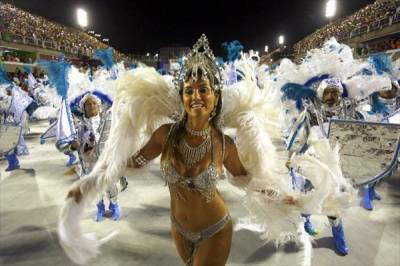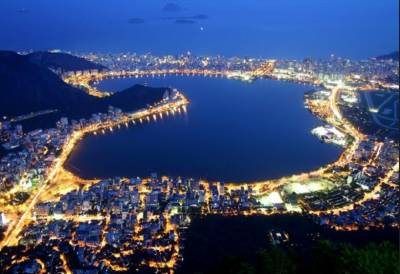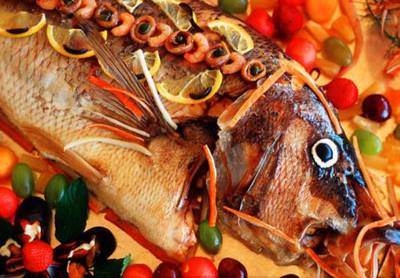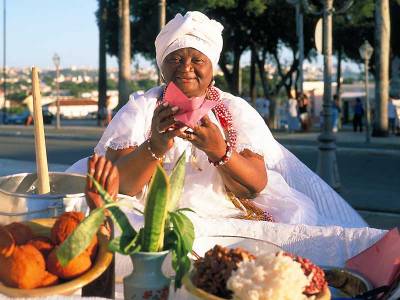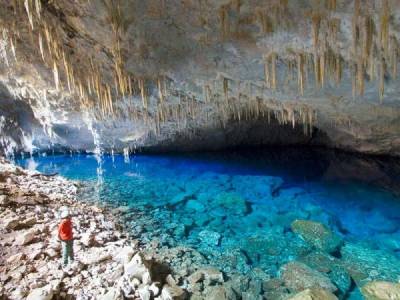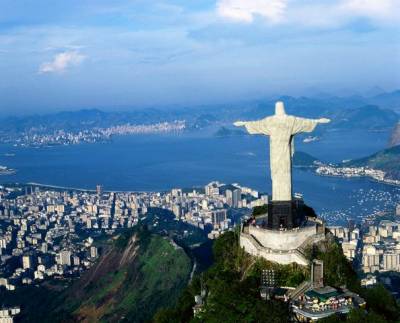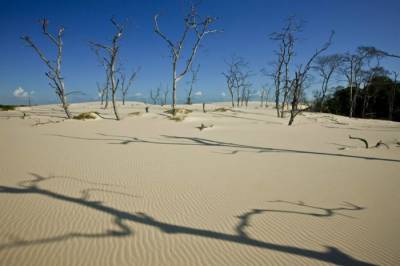BRAZIL
GEOGRAPHY AND GENERAL INFORMATION
Brazil is
in South America and has an area of 547.4 thousand square 8. km. Most of the
territory is in the Southern Hemisphere. Brazil has borders with overseas
department of Guiana, Suriname, Guyana, Venezuela and Colombia to the west -
with Peru in the south-west - Bolivia, Paraguay, Argentina and Uruguay. To the
east by the Atlantic Ocean, Brazil. The length of the coastline from the Guiana
border to the border with Uruguay - 6840 km.
The main features of the geography are the Amazon and the Brazilian Highlands, or plateau. Plateau occupies most of the south-eastern part of the country. Height of the plateau from 300 to 900 meters, in many places it is crossed by river valleys and low mountain ranges. The main mountain ranges Brazilian plateau - Sierra da Mantiqueira, Sierra Mar and to Sierra Zheral. Their height is usually no more than 1200 meters, but some peaks rise to a height of over 2,200 meters (Peak da Bandeira - 2890 meters and Core-Aku - 2232 meters). Major rivers - the Amazon, Madeira, Tapajos, Rio Negro, Parnaíba, Uruguay. Amazon takes more than one third of the territory. It is dominated by plains and rarely exceed altitude of 150 m most of the basin of swamps and flood plain, and the dense jungle. In the north of the Amazon basin is a mountain range - Guiana Highlands - consisting of Sierra Tumukumake (elevations to 850 m), Sierra-Akari (to 600 m) and the Sierra soar (up to 1500 m). On the border with Venezuela, Brazil, is the highest point - Mount Peake da Neblina (3014 m). A very special natural area of Brazil Pantanal (port. "moorland") It is located in the Upper Paraguay River, almost at the center of South America.
It is a vast tectonic depression, the north, east and southeast of the Brazilian Highlands Limited cliffs in the west - the slopes of the Bolivian highlands. Mountain river, flowing down from the Brazilian Highlands, slow down on the low plain of the run and widely dispersed abroad during the summer rains, flooding almost the entire cavity. In winter drought Pantanal - a mosaic of wetlands, lakes and subtle wandering river beds, salt marshes, sand banks and grassy areas.
CLIMATE
Tropical in the equator, and in most inland areas of Brazil, subtropical in the south. Dry and cool winter lasts from June to September, hot summer - from November to April. The average temperature in Brazil + 26 ° C, water - + 20 ° C. In the Amazon region is hot and humid with a Chance of heavy rain. It is recommended to take a trip light sandals, trousers and dresses made of cotton and silk, swimsuits. During a trip to the wild areas of the Amazon will be indispensable clothes that cover your wrists and ankles, waterproof boots, light gloves and mosquito.
LANGUAGE
Portuguese - is the official language of Brazil. With the exception of local languages spoken by few Indian tribes living in remote areas of the country, Portuguese - the only language used by people in everyday life. In the country there is no local dialects. Brazil - the only Portuguese-speaking country in Latin America. In tourist places is also common English, French, German and Italian.
CURRENCY
Currency and exchange: monetary unit in Brazil is the Real. Real Madrid is 100 cents (1 USD is equal to about 2 BRL). There are banknotes in denominations of 1, 5, 10, 50, 100 reais and coins - in 1 real, 1, 5, 10 and 50 centavos. Exchange "travellers checks" and foreign currency can be in banks and exchange offices in shopping centers, hotels, airports and railway stations. Banks are open Monday to Friday from 10:00 to 15:00. Currency exchange offices usually work from 9:00 to 17:30. The currency should take more small bills - they are easier to pay.
TIPPING
"Tip": is usually included in the bill. Most restaurants in Brazil to the bill a 10% tip. The hotel also offers a 10% service charge.
SAFETY
We strongly recommend that you follow the rules of personal safety - do not walk at night, not to go into poor neighborhoods, do not wear gold or shiny decorations, not to change money on the street, to leave unattended on the beach clothes, cameras and wallets, accept invitations from unfamiliar people. Leave documents, money and jewelry in the hotel safe. In the resort tourist areas of Rio, Manaus, Salvador, at Iguassu Falls and other tourist places - safely. Holiday in Brazil.
Water Safety: Due to the strong and cold ocean currents, it is not recommended to swim too far. After dark is dangerous to be on the beach, as at this time it is not protected by the police. In order to avoid heat stroke, you should drink plenty of fluids.
Valuable items: going to the beach, valuables (watch, money, jewelry, and documents) are safe to leave in the hotel safe. The camera or camcorder can take to the beach only in the event that they will be under constant supervision.
KITCHEN
Kitchen: in the Brazilian meat everywhere present. The main ingredients in many dishes and basic side dishes: rice, beans and cassava. The traditional dish that must-try in Brazil - feijoada - black beans, cooked with slices of dried, salted and smoked meat. Feijoada is served with white rice, flour made from cassava root, fried with butter (farofa) and orange slices. In Brazil, a very popular shuraskarii - Grill restaurant, famous worldwide shurasko - grilled meat, a traditional dish prepared on an open fire. In Brazil, the cook very delicious seafood (shrimp, crab, fish, etc.), which are always fresh.
Beverages: Brazilian truly hard liquor is Cachaca, is made from sugar cane. Rum mixed with shredded lime peel, sugar and ice - and enjoy Caipirinha, the national cocktail of Brazil. It is necessary to try a delicious Brazilian coffee, iced tea mate, local beer and coconut water with pulp. In areas where tourists are treated to a variety of Amazonian juices of rare fruits.
SHOPS
In the tour in Brazil come for jewelry (for serious buyers - shops Company "N. Stern" and "Amsterdam Sauer"). Other commodity prices greatly inflated. From souvenirs you can buy a bottle of Caipirinha, crafts made of mahogany, Brazilian spices, amulets Negro, Indian vessels.
TRANSPORT
Bus service between the towns along the coast, is well developed. In big cities, buses and trolley buses are purchased tickets from the conductor, stop on demand. But a trip on a public bus may be unsafe, there is the risk of being robbed. The preferred mode of transport in Rio and other cities - a taxi. The fare depends on the type of taxi, car brand, time of day, service areas, and the like. For the air conditioning in the car will be charged separately. To hire a car, you need to have an international license and a credit card. Offices of major car rental companies (Helts, Avis, National, etc.) are located at airports and major cities. Car rental price is very high - from $ 100 per night. In addition, most of the drivers traffic regulations originally interpreted, the geography of large cities are quite complex, parking places virtually no penalties for violations of the police is very large.
WHAT TO SEE
Pantanal
Pantanal - the largest seasonal wetlands in the world, located in the western part of Brazil, on the border with Bolivia and Paraguay (the Pantanal area, even a little "climbs" in the boundaries of both these border countries). In fact, the Pantanal is a huge bowl-shaped cavity (150 sq km), which is located in the inland delta of the two major river systems - the Paraguay River and Cuiaba. The local abundance and diversity of flora and fauna can be compared only to the Amazon forests, knowingly included Pantanal UNESCO World Heritage List.
In the rainy season the river overflows, the water floods 80% of the Pantanal and it turns into a huge lake-swamp. A myriad of different aquatic plants form floating islands (kamaletos), which escape from the seasonal flood animals and birds. In the dry season of the Pantanal is a series of small poluzarosshih wetlands and lakes, intermittent grassy areas, salt marshes and sandy shoals. By the way, the name of the Pantanal is the Portuguese word pântano, which means "submerged land."
Animal life here can be a maddening any naturalist. The entire expanse of water teeming with alligators Pantanal (them here more than 20 million individuals), you can often find piranha schooling. But the owner is, of course, graceful and deadly jaguar - the largest cat in the New World. Giant river otters, a flock of rare maned wolf, even more rare giant anteater ... Charming capybaras - the largest rodent in the world (reaching five feet at the shoulder) and no less charming sloths hanging on the branches of rare trees. Anaconda rapid and slow tortoise, over which fly colorful parrots, macaws and toucans. Beauty, in a word, though often insecure. But tourists are not confused - every year in the Pantanal comes such a number that environmentalists already sounding the alarm. The development of tourist industry starts to ruin this amazing ecosystem.
And yet, if you decide to come here, the best time is from June to August. Get better before the Cuiaba, Corumba and Campo Grande. Here you have a wide choice of multi-day tours to Pantanal for every taste and budget .
Cathedral of Brasília
Cathedral of the Blessed Virgin Mary - Cathedral Catholic cathedral in the city of Brasilia. Cathedral is a striking modern architectural masterpiece of creativity and construction skills.
The cathedral was designed by Oscar Niemeyer - one of the most prominent architects of the twentieth century. Oscar Niemeyer, who was the chief architect of the city, preferred to use in concrete, metal and glass. This was after the Brasilia these materials have become a tradition for modern construction. And then, in 1950, it seemed one - very brave, others - an extremely unfortunate decision. Of the three materials, and was erected in the years 1959-1960 the cathedral of the new capital.
Cathedral with its form is not like building for religious purposes. The entire project of the cathedral in style modern. Most of the building is underground and on the surface of the dome is visible only collected from 16 colonies in the form of hyperbole, symbolizing the hands raised to the sky. The people of St. Mary's Cathedral is called the Cathedral of the crown of thorns because of its similarity to the divine artifact.
Bonito
Bonito - the unique beauty of a place located in Brazil. There are more than 30 tours available on the district, most of which are based on the study of ecology and natural environment of the area. Part of the program is available for travel only when booked through the official agencies that provide accreditation. The most popular tours include a tour of the Silver River, dive into the natural aquarium, the study of the Blue Lake Cave, a walk through the treetops.
Reservoirs area famous for crystal clear water, brightly colored inhabitants, green vegetation. Depth ranges of natural lakes, so Bonito area is ideal for diving the most diverse levels of complexity.
Here is one of the deepest flooded caves. To get to it, you need to go down to 100 meters, while in front of your eyes appear transparent lake, leaving on 90 meters down.
Visiting places available at any time of the year
Ilha da Queimada Grande
Keymada Grande - an island in the Atlantic Ocean, 35 km from the coast of the Brazilian state of Sao Paulo. In addition to the official name of it is also called the Serpent. And it's true. On this island, there are neither people nor animals - snakes live there alone, but rather one of the most poisonous snakes of the world - the island botrops. Snakes eat only birds. Despite the very small size of the island (about 5kv.km.), there are so many snakes that for every square meter has a few copies.
Generally, each year from the bite botropsov in South America kills more than 100 people, and in fact botrops island, having a long pale golden body - the most venomous animals from this kind, its venom causes immediate tissue necrosis. Therefore, access to people on the shore of the island is strictly prohibited, so as not to repeat the fate of dead snakes lighthouse, which loves to tell Brazilian guides.
Recently, the Brazilian diving is particularly chic dive near Keymada Grande. Botropsy not leave the shore, but the neighborhood is still pretty tickled nerves divers .
Statue Of Christ the Redeemer
Christ the Redeemer statue in Rio de Janeiro is the most famous and popular monument in the world. To look at the statue each year attracts about 2 million visitors. The statue is a symbol of the city and in the whole of Brazil.
It is made of reinforced concrete and soapstone. Dimensions of the statue is impressive. It weighs more than 1,000 tons, a height of about 38 meters, and the size of the hands of about 30 meters.
Climbing up to the foot of the statue, you can witness the fantastic view on the beauty. With stunning view of the whole city, a picturesque bay with Sugar Loaf Mountain and the popular beaches of Ipanema and Copacabana.
The statue was built in 1931. When opening and again in 1965 the statue was consecrated. During this time she had already been repaired twice, and in 2000 he was put in order the night illumination, so now the statue of Christ the Redeemer can be observed not only during the day and night.
In 2007, the statue of Christ the Redeemer was named one of the New Seven Wonders of the World.
Vale de Lua
Alien landscape nestled in the mountains of Brazil and is part of the National Park «Chapada dos Veadeiros». Want to briefly lost in time and space, then you ... here!
Ancient plateau on which the valley was formed more than 1.8 billion years ago and is the oldest natural ensemble of the world's cleanest quartz.
All this time the quartz rocks eroded river San Miguel, so they are intricately and perfectly polished blurred.
Rock streak numerous craters, which adds to this amazing place even more extraterrestrial perception. And between the highest of the craters can be distinguished fossilized remains of animals and plants.
Lencois Maranhenses National Park
Park Lencois-Maranensis located in the state of Maranhão, northeastern Brazil. The National Park is a flat country, sleeps huge sand dunes, a total area of 1,000 square kilometers. From the side it seems that this is a common desert with no roads, lush vegetation and life, yet it is not. Lencois-Maranensis - area of seasonal rains. Thanks to abundant precipitation, fresh clean water is stored between the dunes, forming a mottled surface of the lagoon with a lot of different types of fish. Most park becomes inundated from July to September. In the dry season, water areas almost completely dried up, but the following year in the life of the lagoon revived by birds carrying the eggs of fish from the sea. The park was established on 2 June 1981 and is always open to visitors.

